A Solution Manual and Notes for:
Applied Optimal Estimation
by Arthur Gelb.
John L. Weatherwax∗
Dec 3, 1996
Introduction
Here you’ll find various notes and derivations of the technical material I made as I worked
through this book. There is also quite a complete set of solutions to the various end of
chapter problems. I did much of this in hopes of improving my understanding of Kalman
filtering and thought it might be of interest to others. I have tried hard to elliminate any
mistakes but it is certain that some exit. I would appreciate constructive feedback (sent to
the email below) on any errors that are found in these notes. I will try to fix any corrections
that I recieve.
In addition, there were several problems that I was not able to solve or
that I am not fully confident in my solutions for. If anyone has any suggestions at solution
methods or alternative ways to solve given problems please contact me. Finally, some of the
derivations found here can be quite long (since I really desire to fully document exactly how
to do each derivation) many of these can be skipped if they are not of interest.
I hope you enjoy this book as much as I have and that these notes might help the further
development of your skills in Kalman filtering.
∗wax@alum.mit.edu
1
�
Chapter 1: Introduction
Notes On The Text
optimal estimation with two measurements of a constant value
We desire our estimate ˆx of x to be a linear combination of the two measurements zi for
i = 1, 2. Thus we take ˆx = k1z1 + k2z2, and define ˜x to be our estimate error given by
˜x = ˆx − x. To make our estimate ˆx unbiased requires we set E[˜x] = 0 or
E[˜x] = E[k1(x + v1) + k2(x + v2) − x] = 0
= E[(k1 + k2)x + k1v1 + k2v2 − x]
= E[(k1 + k2 − 1)x + k1v1 + k2v2]
= (k1 + k2)x − x = (k1 + k2 − 1)x = 0 ,
thus this requirement becomes k2 = 1 − k1 which is the same as the books Equation 1.0-4.
Next lets pick k1 and k2 (subject to the above constraint such that) the error as small as
possible. When we take k2 = 1 − k1 we find that ˆx is given by
so ˜x is given by
ˆx = k1z1 + (1 − k1)z2 ,
˜x = ˆx − x = k1z1 + (1 − k1)z2 − x
= k1(x + v1) + (1 − k1)(x + v2) − x
= k1v1 + (1 − k1)v2 .
Next we compute the expected error or E[˜x2] and find
(1)
E[˜x2] = E[k2
1σ2
1σ2
= k2
= k2
1 + 2k1(1 − k1)v1v2 + (1 − k1)2v2
1v2
2]
1 + 2k1(1 − k1)E[v1v2] + (1 − k1)2σ2
1 + (1 − k1)2σ2
2 ,
2
since E[v1v2] = 0 as v1 and v2 are assumed to be uncorrelated. This is the books equation 1.0-
5. We desire to minimize this expression with respect to the variable k1. Taking its derivative
with respect to k1, setting the result equal to zero, and solving for k1 gives
2k1σ2
1 + 2(1 − k1)(−1)σ2
2 = 0 ⇒ k1 =
σ2
2
σ2
1 + σ2
2
.
Putting this value in our expression for E[˜x2] to see what our minimum error is given by we
find
E[˜x2] = σ2
2
σ2
22
2)2σ2
= 1
1 + σ2
1 =
2−1
2 + σ2
1
σ2
σ2
1
+
σ2
1 + σ2
σ2
1σ2
2
1 + σ2
1
+ 1
σ2
2
(σ2
1
σ2
1
=
=
22
1
σ2
2
σ2
1 + σ2
σ2
1σ2
2
1 + σ2
2)
(σ2
,
�
which is the books equation 1.06. Then our optimal estimate ˆx take the following form
ˆx = σ2
2
1 + σ2
σ2
2 z1 + σ2
1
1 + σ2
σ2
2 z2 .
Some special cases of the above that validate its usefulness are when each measurement
contributes the same uncertainty then σ1 = σ2 and we see that ˆx = 1
2z2, or the average
of the two measurements. As another special case if one measurement is exact i.e. σ1 = 0,
then we have ˆx = z1 (in the same way if σ2 = 0, then ˆx = z2).
2z1 + 1
Problem Solutions
Problem 1-1 (correlated measurements)
For this problem we are now going to assume that E[v1v2] = ρσ1σ2 i.e. that the noise v1 and
v2 are correlated. Recall from above that the condition E[˜x] = 0 requires that our estimate
ˆx = k1z1 + k2z2 requires k2 = 1 − k1. Next we compute the expected error or E[˜x2] and in
this case using Equation 1 for ˜x we find
E[˜x2] = E[k2
1σ2
1σ2
= k2
= k2
1v2
1 + 2k1(1 − k1)v1v2 + (1 − k1)2v2
2]
1 + 2k1(1 − k1)E[v1v2] + (1 − k1)2σ2
2
1 + 2k1(1 − k1)ρσ1σ2 + (1 − k1)2σ2
2 .
(2)
To find a minimum variance estimator we will take the derivative of E[˜x2] with respect to
k1, set the result equal to zero, and then solve for k1. We have
dE[˜x2]
dk1
= 0 ⇒ 2k1σ2
1 + 2ρ(1 − k1)σ1σ2 + 2ρk1(−1)σ1σ2 + 2(1 − k1)(−1)σ2
2 = 0 .
or dividing by 2
k1σ2
1 + ρ(1 − k1)σ1σ2 − ρk1σ1σ2 − (1 − k1)σ2
2 = 0 .
On solving for k1 in this expression we find
k1 =
σ2
2 − ρσ1σ2
σ2
2 − 2ρσ1σ2 + σ2
1
,
as claimed. From symmetry k2 = 1 − k1 is given by
k2 = 1 − k1 =
1 − 2ρσ1σ2 + σ2
σ2
2 − σ2
1 − 2ρσ1σ2 + σ2
σ2
2
2 + ρσ1σ2
With these values for k1 and k2 and introducing
D ≡ σ2
1 − 2ρσ1σ2 + σ2
2 ,
(3)
(4)
=
σ2
1 − ρσ1σ2
σ2
1 − 2ρσ1σ2 + σ2
2
.
�
to simplify notation the minimum mean square error given by Equation 2 becomes
E[˜x2] =
1 − ρσ1σ2)σ1σ2 + (σ2
2
1 − ρσ1σ2)2σ2
=
=
1
1
1σ2
1σ2
2)
1 + 2ρ(σ2
2 − ρσ3
1σ2 + ρ2σ2
D2(σ2
D2σ2
D2σ2
1σ3
2 − 2ρσ3
D2σ2
1σ4
D2 σ2
2 − ρσ1σ2)2σ2
2 − ρσ1σ2)(σ2
1σ2
2 + ρ2σ2
2 − 2ρσ1σ2σ2
1(σ4
2)
1σ2
+ 2ρσ1σ2(σ2
1σ2 − ρσ1σ3
2 + ρ2σ2
2)
+ σ2
2(σ4
1 − 2ρσ3
1
1σ3
2 − 2ρσ3
1σ4
2 + ρ2σ4
1σ2
2 − 2ρ2σ4
2 − 2ρ2σ2
2
1σ4
1σ3
2 + ρ2σ2
2(1 − 2ρ2 + ρ2) + σ4
1(1 − ρ2) + σ1σ2(2ρ)(−1)(1 − ρ2)
2(1 − ρ2) + σ2
2 − 2ρσ1σ2
1 + σ2
2(ρ2 − 2ρ2 + 1) + σ3
1σ2
2
1σ4
2 + 2ρ3σ3
+ 2ρσ3
+ σ4
1σ2
1
σ2
1σ2
2
1σ2
1σ3
2
1σ3
=
=
σ2
1σ2
σ2
2(1 − ρ2)
D2
2(1 − ρ2)
1σ2
σ2
σ2
1 − 2ρσ1σ2 + σ2
2
.
=
=
2(2ρ3 − 2ρ)
Note that this last expression is zero when ρ = ±1. Our estimate ˆx is then given by
ˆx = σ2
2 − ρσ1σ2
σ2
2 − 2ρσ1σ2 + σ2
1 z1 + σ2
1 − ρσ1σ2
σ2
1 − 2ρσ1σ2 + σ2
2 z2 .
(5)
As before we now consider some special cases. If ρ = +1 then the errors are totally correlated
and we see that
σ2
2 − σ1σ2
σ2
1 − 2σ1σ2 + σ2
2
=
σ2(σ2 − σ1)
(σ1 − σ2)2 =
σ2
,
σ2 − σ1
k1 =
with k2 is given by
so that ˆx is given by
,
k2 = 1 − k1 = −σ1
σ2 − σ1
σ2 − σ1 z2 =
σ2 − σ1 z1 + −σ1
ˆx = σ2
σ2z1 − σ1z2
σ2 − σ1
.
If ρ = −1 the errors are totally uncorrelated and we have
σ2
σ2
2 + σ1σ2
k1 =
σ2
1 + 2σ1σ2 + σ2
2
σ2 + σ1
=
.
with k2 is given by
so that ˆx is given by
k2 = 1 − k1 =
σ1
σ2 − σ1
,
ˆx = σ2
σ2 + σ1 z1 + σ1
σ2 + σ1 z2 =
σ2z1 + σ1z2
σ2 + σ1
.
�
Problem 1-2 (E[˜x2] without the requirement that E[˜x] = 0)
We are told that our measurements z1 and z2 are given as noised measurements of a constant
as z1 = x + v1 and z2 = x + v2, while our estimate of x or ˆx is to be constructed as a linear
combination of zi as ˆx = k1z1 + k2z2. Now defining ˜x as before we have in this case that
˜x = ˆx − x = k1(x + v1) + k2(x + v2) − x = (k1 + k2 − 1)x + k1v1 + k2v2 .
So that ˜x2 is given by
˜x2 = (k1 + k2 − 1)2x2 + 2x(k1 + k2 − 1)(k1v1 + k2v2) + (k1v1 + k2v2)2
1v2
= (k1 + k2 − 1)2x2 + 2xk1(k1 + k2 − 1)v1 + 2xk2(k1 + k2 − 1)v2 + (k2
1 + 2k1k2v1v2 + k2
2v2
2) .
Taking the expectation of this expression and using the facts that the mean of the noise is
zero so E[vi] = 0 and x is a constant gives
E[˜x2] = (k1 + k2 − 1)2x2 + k2
1σ2
1 + 2k1k2E[v1v2] + k2
2σ2
2 .
For simplicity lets assume that the two noise sources are uncorrelated i.e. E[v1v2] = 0. Then
to find the minimum of this expression we take derivatives with respect to k1 and k2 set each
expression equal to zero and solve for k1 and k2. We find the derivatives given by
∂E[˜x2]
∂k1
∂E[˜x2]
∂k2
= 2(k1 + k2 − 1)x2 + 2k1σ2
= 2(k1 + k2 − 1)x2 + 2k2σ2
1 = 0
2 = 0 .
When we group terms by the coefficients k1 and k2 we get the following system
(x2 + σ2
x2k1 + (x2 + σ2
1)k1 + x2k2 = x2
2)k2 = x2 .
To solve this system for k1 and k2 we can use Cramer’s rule. We find
=
x2σ2
2
2)x2 + σ2
1σ2
2
(σ2
1 + σ2
k1 =
k2 =
x2
x2
x2 x2 + σ2
x2
x2 + σ2
1
x2
x2 + σ2
x2 + σ2
1 x2
2
2
x2
1σ2
2
x2
2)x2 + σ2
1 + σ2
(σ2
=
x2σ2
1
2)x2 + σ2
1σ2
2
(σ2
1 + σ2
,
both of which are functions of the unknown variable x. An interesting idea would be to con-
sider the iterative algorithm where we initially estimate x above using an unbiased estimator
and then replace the x above with this estimate obtaining values for k1 and k2. One could
then use these to estimate x again and put this value into the above expressions for k1 and
k2. Doing this several times one gets an iterative algorithm as the estimation procedure.
�
Problem 1-3 (estimating a constant with three measurements)
For this problem our three measurements are related to the unknown value of x from as
z1 = x + v1, z2 = x + v2, and z3 = x + v3, and our estimate will be a linear combination of
them as ˆx = k1z1 + k2z2 + k3z3. To have an unbiased estimate compute the expectation of
˜x = ˆx − x which we find to be
˜x = ˆx − x
= k1z1 + k2z2 + k3z3 − x
= k1(x + v1) + k2(x + v2) + k3(x + v3) − x
= (k1 + k2 + k3 − 1)x + k1v1 + k1v1 + k2v2 + k3v3 .
(6)
(7)
To make ˆx an unbiased estimate of x we require that E[˜x] = 0. This in tern requires
k1 + k2 + k3 − 1 = 0 or
k3 = 1 − k1 − k2
Thus our unbiased estimate of x now takes the form
ˆx = k1z1 + k2z2 + (1 − k1 − k2)z3 .
We will now pick k1 and k2 such that the mean square error E[˜x2] is a minimum. With this
functional form for ˆx we have using Equation 6 that
˜x2 = (k1v1 + k2v2 + k3v3)2
= k2
1v2
1 + k2
2v2
2 + k2
3v2
3 + 2k1k2v1v2 + 2k1k3v1v3 + 2k2k3v2v3 .
Taking the expectation of the above expression, assuming uncorrelated measurements E[vivj] =
0 when i 6= j and recalling Equation 7 we have
2σ2
E[˜x2] = k2
1 + k2
1σ2
(8)
2 + (1 − k1 − k2)2σ2
3 .
to minimize this expression we take the partial derivatives with respect to k1 and k2 and set
the resulting expressions equal to zero. This gives
∂E[˜x2]
∂k1
∂E[˜x2]
∂k2
= 2k1σ2
= 2k2σ2
1 + 2(1 − k1 − k2)(−1)σ2
2 + 2(1 − k1 − k2)(−1)σ2
3 = 0
3 = 0 .
Now solving these two equations for k1 and k2 we find
k1 =
k2 =
σ2
2σ2
3
2 + σ2
1σ2
3 + σ2
2σ2
3
σ2
1σ2
1σ2
σ2
3
2 + σ2
1σ2
3 + σ2
2σ2
3
σ2
1σ2
=
=
σ32
σ1
σ32
σ2
1
1
+ 1
σ22
+ σ1
σ12 .
+ 1 + σ2
�
From these we can compute k3 = 1 − k1 − k2 to find
k3 = 1 − k1 − k2 = 1 −
=
σ2
1σ2
2
3 + σ2
1σ2
2 + σ2
2σ2
3
σ2
1σ2
=
1σ2
σ2
σ2
2σ2
3
3 + σ2
1σ2
2 + σ2
1
σ2
1σ2
3
3 + σ2
1σ2
2 + σ2
2σ2
1σ2
σ2
3
1σ2
3 + σ2
3 and using Equation 8 we see that
3 + σ2
1σ2
3 + σ2
1σ2
1σ2
2σ2
σ2
3
D
2 =
2σ2
3 −
σ12 .
+ σ3
D2 σ2
1 ,
2σ2
3
2σ2
1σ2
2σ2
3
2σ2
1 + σ3
σ22
D2 = σ2
1
+ 1
σ2
2
σ2
3
1
+ 1
σ2
Then by defining D ≡ σ2
3σ4
σ4
1σ2
2
D2 +
E[˜x2] =
2 + σ2
1σ2
2σ4
σ4
3σ2
1
D2 +
2σ3
1σ2
σ2
3
3 + σ2
1σ2
2 + σ2
1σ2
σ2
=
=
3σ2
2
σ4
1σ4
as we were to show.
Problem 1-4 (estimating the initial concentration)
We are told that our estimate of the concentration, zi are noisy measurements of the time-
decayed initial concentration x0 and so have the form
zi = x0e−ati + vi ,
(9)
for i = 1, 2. The book provides us with a functional form of an estimator ˆx0 we could use to
estimate x0, and asks us to show that it is unbiased. We could begin by attempting to esti-
mate the initial concentration x0 using a expression that is linear in the two measurements.
That is we might consider
ˆx0 = k1z1 + k2z2 ,
as has been done else where in the book. From the given form of the measurements in
Equation 9 it might be better however to estimate x0 using the following
ˆx0 = k1eat1z1 + k2eat2z2 ,
with k1 and k2 unknown. Since in that case the exponential parts eati, multiplied by zi will
“remove” the corresponding factor found in Equation 9 and provide a more direct estimate
of x0. We next define our estimation error ˜x0 as ˜x0 = ˆx0− x0. To have an unbiased estimator
requires that E[˜x0] = 0. Using this last form form ˆx0 this later expectation is given by
E[˜x0] = E[k1eat1(x0e−at1 + v1) + k2eat2(x0e−at2 + v2) − x0] = 0 .
Since E[vi] = 0 the above gives k1x0 + k2x0 − x0 = 0 so that k2 = 1− k1. Thus our estimator
ˆx0 looks like
ˆx0 = k1eat1z1 + (1 − k1)eat2z2 ,
�
and is in the form suggested in the book. To have the optimal estimator we next select k1
such that our expected square error is the smallest. To do this we compute our expected
square error or E[˜x2] and find
E[˜x2
0] = E[(k1eat1(e−at1x0 + v1) + k2eat2(e−at2x0 + v2) − x0)2]
= E[(k1x0 + k1eat1v1 + k2x0 + k2eat2v2 − x0)2]
= E[(k1eat1v1 + k2eat2v2)2]
= E[k2
= k2
1 + 2k1k2eat1eat2v1v2 + k2
2e2at2v2
2]
1e2at1v2
2e2at2σ2
2 ,
1e2at1 σ2
1 + k2
(10)
assuming uncorrelated measurements E[v1v2] = 0. Taking the derivative of this expression
with respect to k1 (while recalling that k2 = 1 − k1 and setting this derivative equal to zero
we get
2k1e2at1σ2
1 + 2(1 − k1)(−1)e2at2 σ2
2 = 0 .
Solving for k1 we find
k1 =
(eat2σ2)2
(eat1σ1)2 + (eat2σ2)2 =
σ2
2
1e−2a(t2−t1) .
σ2
2 + σ2
Using this then k2 becomes
(eat1σ1)2
k2 = 1 − k1 =
σ2
1
2e2a(t2−t1) .
To simplify the notation of the algebra that follows we define A1 = e2at1σ2
so that the variables ki in terms of Ai are given as k1 = A2
have that Equation 10 becomes
(eat1σ1)2 + (eat2σ2)2 =
1 + σ2
σ2
A1+A2
and k2 = A1
1 and A2 = e2at2 σ2
2
. Then we
A1+A2
A2
2
(A1 + A2)2 A1 +
A2
1
(A1 + A2)2 A2 =
A1A2
(A1 + A2)2 (A1 + A2) =
A1A2
A1 + A2
E[(ˆx0 − x0)2] =
=
1
A22
1
= e−2t1a
σ2
1
A12
+ 1
2 −1
e−2t2a
σ2
+
,
as we were to show.
�
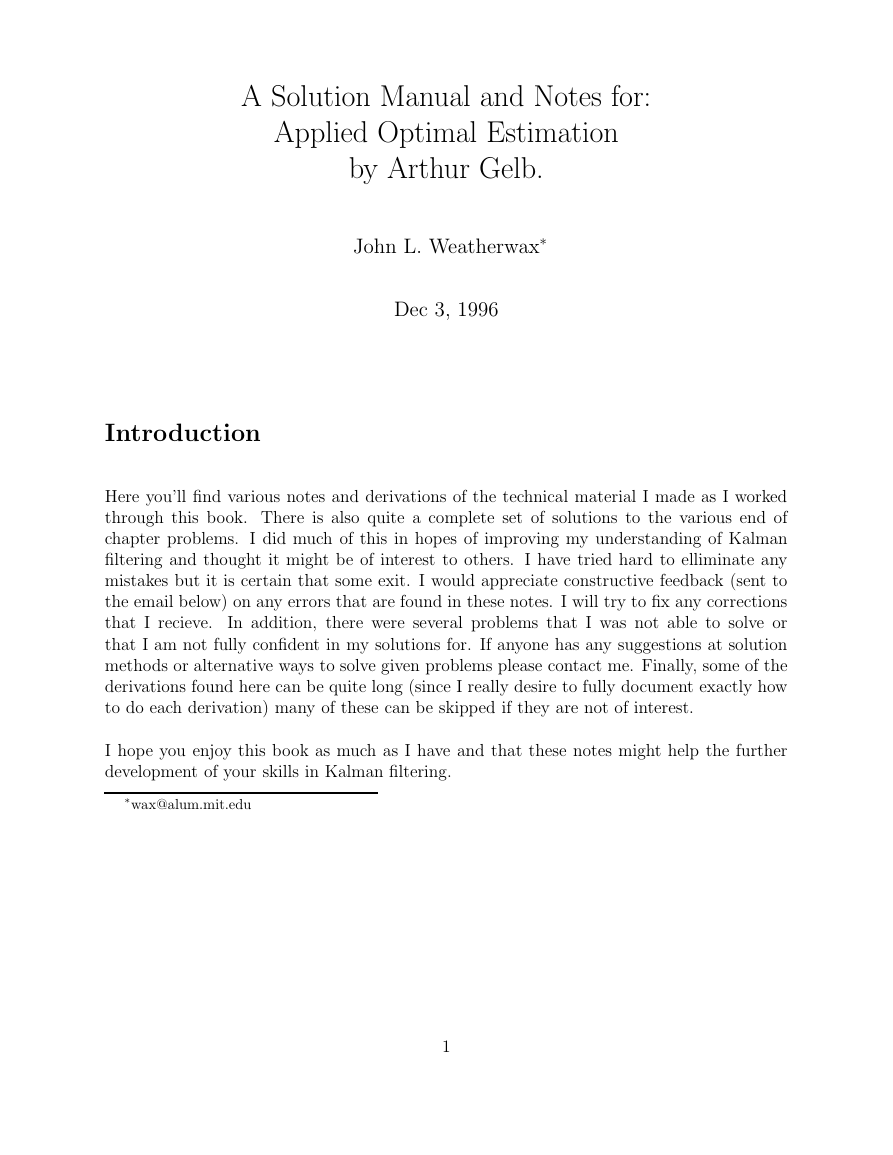
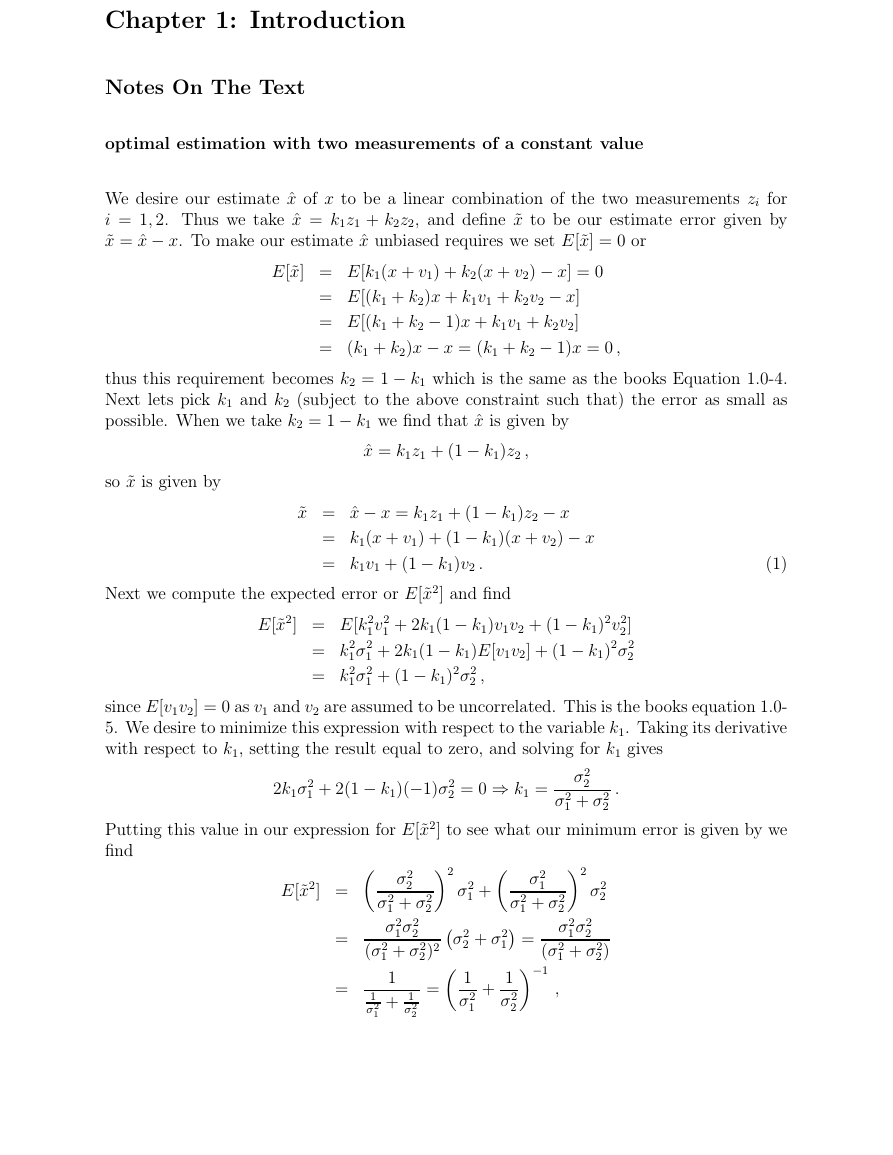


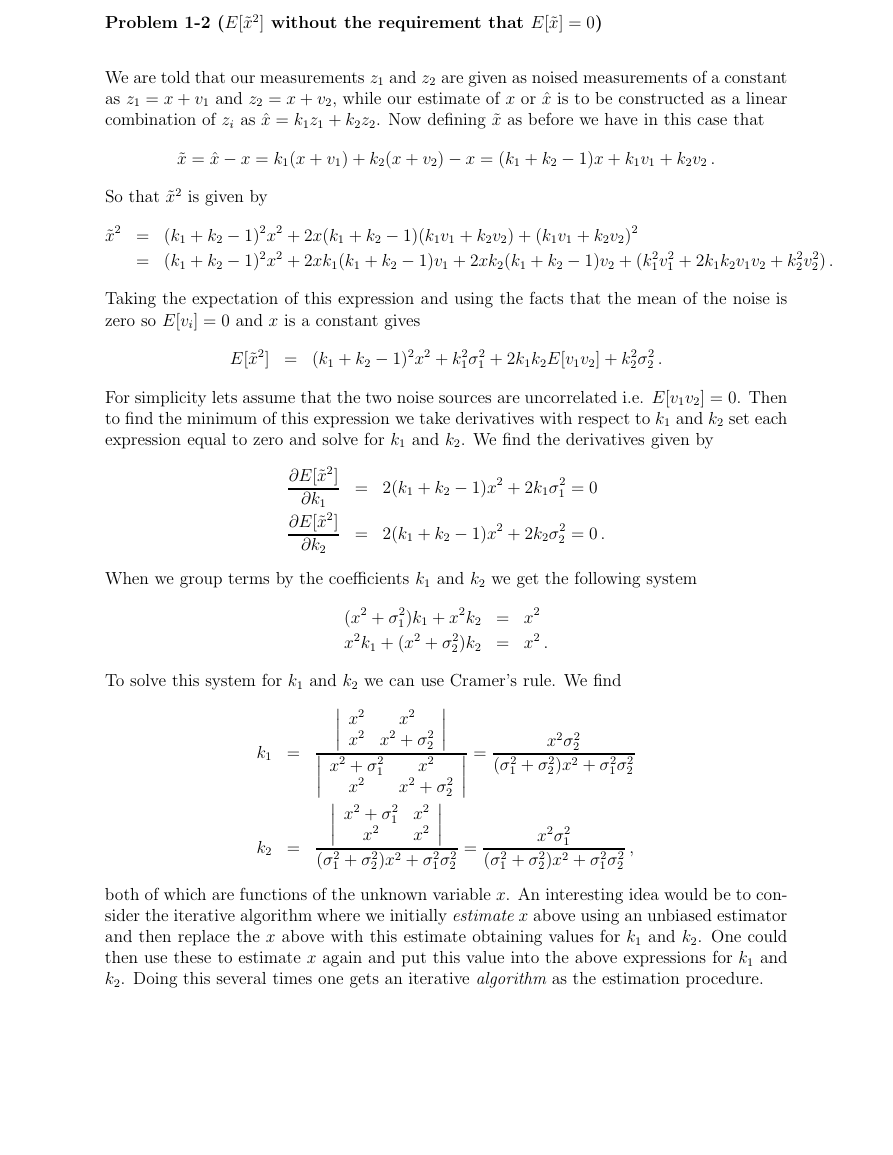

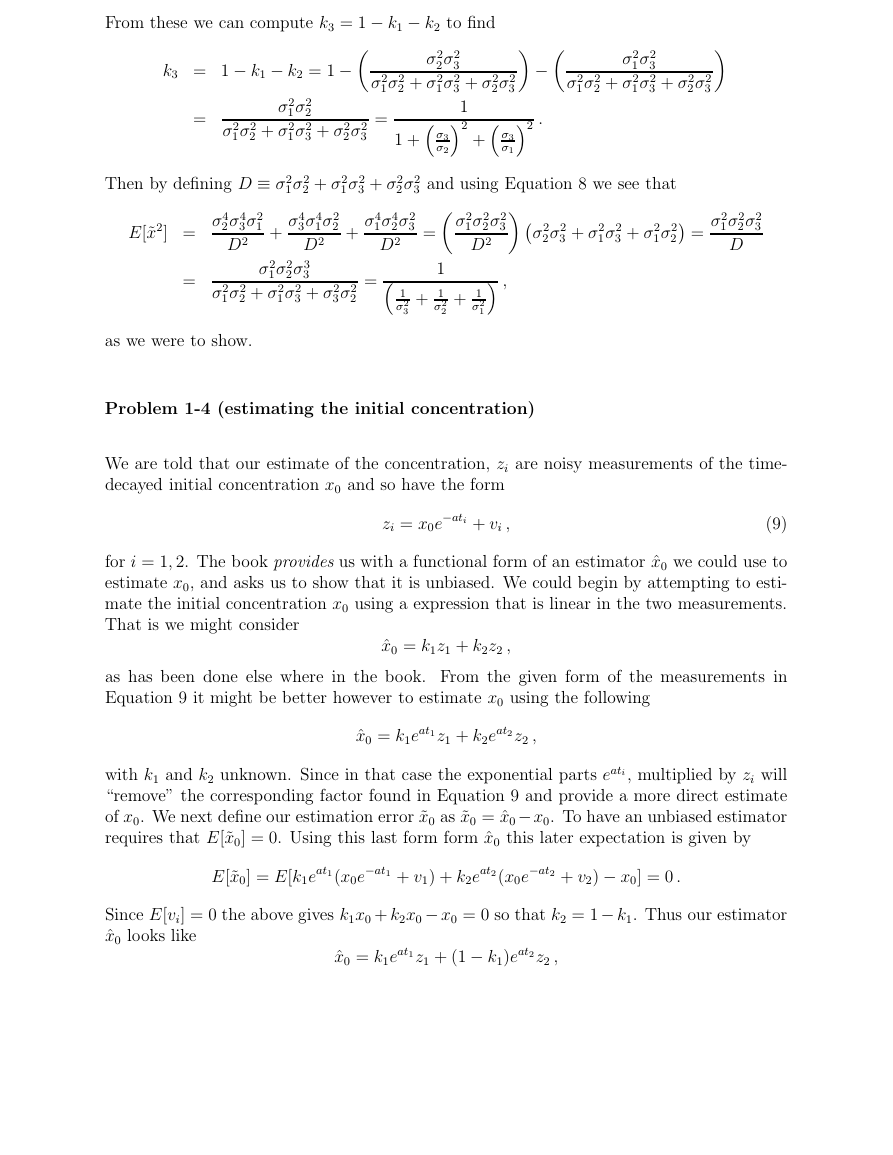
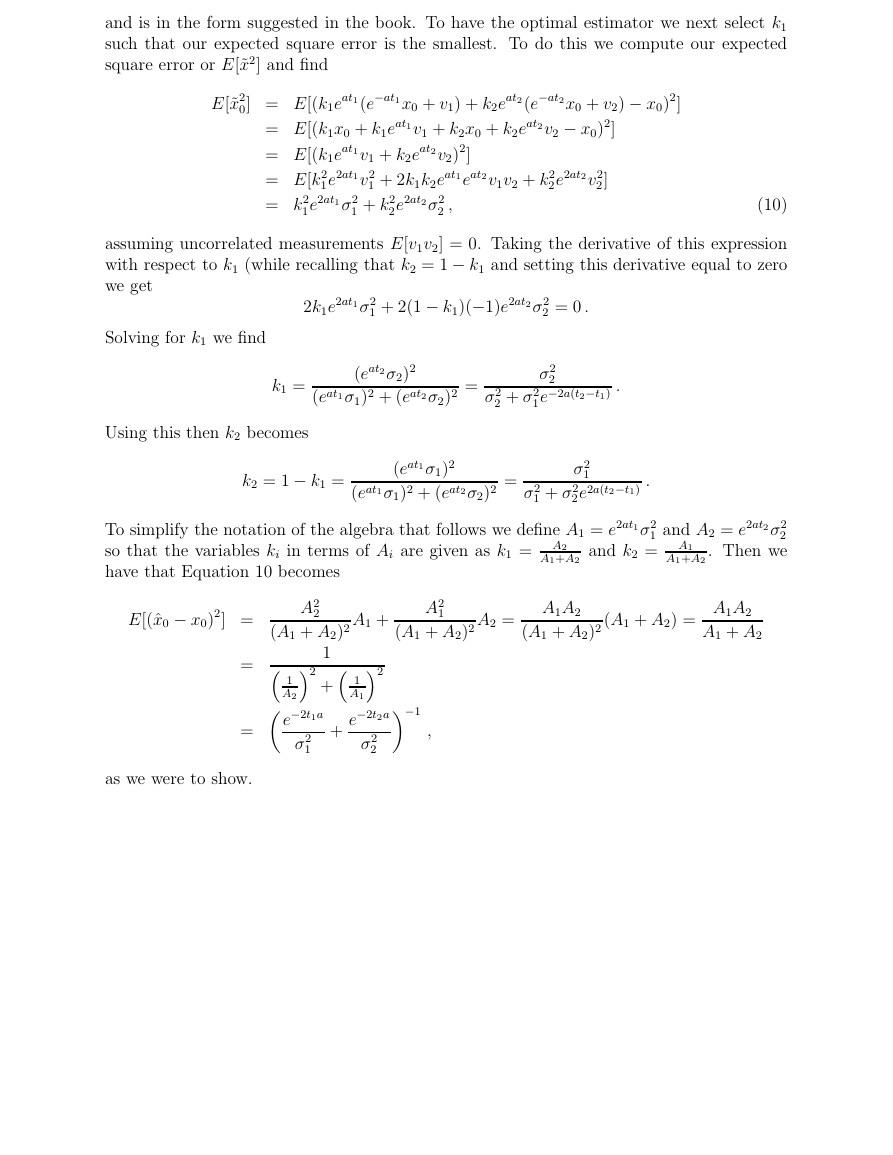








 2023年江西萍乡中考道德与法治真题及答案.doc
2023年江西萍乡中考道德与法治真题及答案.doc 2012年重庆南川中考生物真题及答案.doc
2012年重庆南川中考生物真题及答案.doc 2013年江西师范大学地理学综合及文艺理论基础考研真题.doc
2013年江西师范大学地理学综合及文艺理论基础考研真题.doc 2020年四川甘孜小升初语文真题及答案I卷.doc
2020年四川甘孜小升初语文真题及答案I卷.doc 2020年注册岩土工程师专业基础考试真题及答案.doc
2020年注册岩土工程师专业基础考试真题及答案.doc 2023-2024学年福建省厦门市九年级上学期数学月考试题及答案.doc
2023-2024学年福建省厦门市九年级上学期数学月考试题及答案.doc 2021-2022学年辽宁省沈阳市大东区九年级上学期语文期末试题及答案.doc
2021-2022学年辽宁省沈阳市大东区九年级上学期语文期末试题及答案.doc 2022-2023学年北京东城区初三第一学期物理期末试卷及答案.doc
2022-2023学年北京东城区初三第一学期物理期末试卷及答案.doc 2018上半年江西教师资格初中地理学科知识与教学能力真题及答案.doc
2018上半年江西教师资格初中地理学科知识与教学能力真题及答案.doc 2012年河北国家公务员申论考试真题及答案-省级.doc
2012年河北国家公务员申论考试真题及答案-省级.doc 2020-2021学年江苏省扬州市江都区邵樊片九年级上学期数学第一次质量检测试题及答案.doc
2020-2021学年江苏省扬州市江都区邵樊片九年级上学期数学第一次质量检测试题及答案.doc 2022下半年黑龙江教师资格证中学综合素质真题及答案.doc
2022下半年黑龙江教师资格证中学综合素质真题及答案.doc